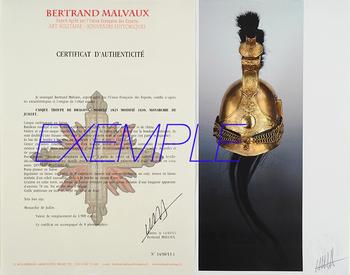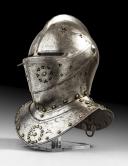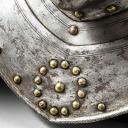
Cuirassier helmet, Germany (Nuremberg), c. 1630. PHILIPPE MISSILLIER COLLECTION, Giquello Auction House, Drouot - rooms 5-6, March 6th & 7th, 2025.
Sold out
PHILIPPE MISSILLIER COLLECTION
ANCIENT TIMES - BOOKS - 17TH CENTURY FIREARMS
HUNTING ART - PHALERISTICS
18TH AND 19TH CENTURY WEAPONS - RUSSIAN ART
Friday, March 7, 2025 - 11am to 12pm
AFRICA AND OCEANIA - FAR EAST
Friday, March 7, 2025 - 2pm
ISLAMIC AND INDIAN ART
Drouot - rooms 5-6
EXHIBITION
Tuesday, March 4 from 11am to 6pm
Wednesday, March 5 from 11am to 6pm
Thursday, March 6 from 11am to 12pm
Phone during the exhibition +33(0)1 48 00 20 05
GIQUELLO
Alexandre Giquello
Violette Stcherbatcheff
5, rue La Boétie - 75008 Paris
+33 (0)1 47 42 78 01 - info@giquello.net
Subject to approval
No. 2002 389
CONTACT
Claire Richon
+33(0)1 47 70 48 00
c.richon@giquello.net
SPECIALIST
Marina Viallon Specialist
+33 (0)6 72 42 57 24
marina.viallon@yahoo.fr
Lot n° 81 (from the sale)
Cuirassier's Helmet Germany (Nuremberg), c. 1630
H 35 cm - W 30cm
174 CH
15,000/25,000 €
Provenance:
- Christie's and Manson & Woods Ltd, London, February 20, 1991, lot 63
Iron cuirassier's helmet, composed of a crest, a chin guard, a two-piece mezail consisting of a visor pierced with two slots for vision and a bevor, extended by a gorget with two plates at the front and back. The upper edge of the visor, scalloped, is adorned with pierced trefoil motifs, also found on each side of the chin guard and the bevor, along with hearts arranged in a circle around a decorative rivet. Fine engraved lines and rope motifs highlight the edges of the plates and the corners of the piece. The iron rivets, once used to secure the internal lining (some leathers are preserved) or for decorative purposes, have brass-covered heads. Brass hooks secure the closures of the chin guard and mezail, and a quill holder of the same metal is attached at the back at the base of the crest. A spring-loaded button on the right secures the closure of the visor with the bevor. On either side of the rivet circle on the front part of the gorget, the control mark of the city of Nuremberg (city arms) and that of the armorer (six-pointed star) are visible. Later, a large iron ring was attached to the back of the gorget, perhaps to secure the object with a chain for a funerary or votive installation.
Overall good condition, some accidents and traces of corrosion.
ANCIENT TIMES - BOOKS - 17TH CENTURY FIREARMS
HUNTING ART - PHALERISTICS
18TH AND 19TH CENTURY WEAPONS - RUSSIAN ART
Friday, March 7, 2025 - 11am to 12pm
AFRICA AND OCEANIA - FAR EAST
Friday, March 7, 2025 - 2pm
ISLAMIC AND INDIAN ART
Drouot - rooms 5-6
EXHIBITION
Tuesday, March 4 from 11am to 6pm
Wednesday, March 5 from 11am to 6pm
Thursday, March 6 from 11am to 12pm
Phone during the exhibition +33(0)1 48 00 20 05
GIQUELLO
Alexandre Giquello
Violette Stcherbatcheff
5, rue La Boétie - 75008 Paris
+33 (0)1 47 42 78 01 - info@giquello.net
Subject to approval
No. 2002 389
CONTACT
Claire Richon
+33(0)1 47 70 48 00
c.richon@giquello.net
SPECIALIST
Marina Viallon Specialist
+33 (0)6 72 42 57 24
marina.viallon@yahoo.fr
Lot n° 81 (from the sale)
Cuirassier's Helmet Germany (Nuremberg), c. 1630
H 35 cm - W 30cm
174 CH
15,000/25,000 €
Provenance:
- Christie's and Manson & Woods Ltd, London, February 20, 1991, lot 63
Iron cuirassier's helmet, composed of a crest, a chin guard, a two-piece mezail consisting of a visor pierced with two slots for vision and a bevor, extended by a gorget with two plates at the front and back. The upper edge of the visor, scalloped, is adorned with pierced trefoil motifs, also found on each side of the chin guard and the bevor, along with hearts arranged in a circle around a decorative rivet. Fine engraved lines and rope motifs highlight the edges of the plates and the corners of the piece. The iron rivets, once used to secure the internal lining (some leathers are preserved) or for decorative purposes, have brass-covered heads. Brass hooks secure the closures of the chin guard and mezail, and a quill holder of the same metal is attached at the back at the base of the crest. A spring-loaded button on the right secures the closure of the visor with the bevor. On either side of the rivet circle on the front part of the gorget, the control mark of the city of Nuremberg (city arms) and that of the armorer (six-pointed star) are visible. Later, a large iron ring was attached to the back of the gorget, perhaps to secure the object with a chain for a funerary or votive installation.
Overall good condition, some accidents and traces of corrosion.
Reference :
Étude Giquello, Drouot - salles 5-6, les 6 & 7 mars 2025

Next update Friday, april 4th at 1:30 PM
FOR ALL PURCHASES, PAYMENT IN MULTIPLE CHECKS POSSIBLE
bertrand.malvaux@wanadoo.fr 06 07 75 74 63
An authenticity certificate of the item including the description published on the site, the period, the sale price, accompanied by one or more color photographs is automatically provided for any item priced over 130 euros. Below this price, each certificate is charged 5 euros.
Only items sold by me are subject to an authenticity certificate, I do not provide any expert reports for items sold by third parties (colleagues or collectors).

